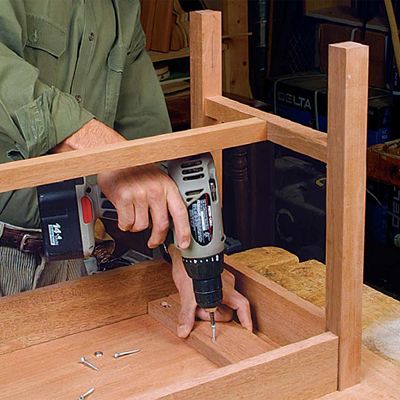How to Attach a Tabletop
Six methods to control and direct wood movement
Synopsis: While you cannot prevent a solid-wood tabletop from moving seasonally, there are several time-tested methods for attaching a tabletop that will allow you to control expansion and contraction and ensure the integrity of the table for its lifetime. In this article, contributing editor Mario Rodriguez shares six ways to secure a tabletop to allow for seasonal wood movement — traditional pocket holes, two kinds of metal clips, wooden blocks, tongue and groove blocks, and beveled cleats. He discusses design and construction of each and advises on their use.
Attaching a top to its base is a critical aspect of table design and construction. Regardless of the method you choose, it should meet the following criteria: The top must be firmly attached to the base; the top must remain flat; a solid-wood top must be allowed to move seasonally; the attachment method shouldn’t compromise the design of the table or complicate its construction. I’ll describe six ways of attaching a tabletop that meet these requirements, along with the reasoning behind each method.
The most important factor to consider when deciding how to attach a tabletop is wood movement. We all know that solid wood moves seasonally across the grain. It’s a fact; you can’t do anything to stop it. In the summer, a board will expand across its width because of an increase in humidity. During cold months, the same board will shrink and become narrower. If no allowance is made to control or direct this seasonal movement, a tabletop might buckle, or worse, crack and split.
When calculating how much a board will move, I usually allow from 1 ⁄8 in. to 3 ⁄16 in. for every 12 in. of width. Therefore, I would anticipate that a 42-in.-wide tabletop might move about 1 ⁄2 in. overall. This is only a general guide, and certain factors must be taken into account. For instance, in parts of the country with low humidity, wood movement might be minimal.
Another factor is the type of wood you’re using: Cherry moves less than white oak but more than mahogany, while flatsawn wood moves more than quartersawn. For more on this subject, read Understanding Wood by R. Bruce Hoadley (The Taunton Press, 2000).
Once you accept that the tabletop will move, you can control or direct this movement so that it doesn’t disrupt how the table works or looks (see the drawings below). For a freestanding table with a uniform overhang, I anchor the top to the base at the center of the end rails. That way, any cross-grain movement will occur evenly along each long-grain side. On a demilune (half-round) table, I pin the back edge of the top, which typically is placed against a wall. Conversely, on a writing table I might fix the top along the front of the table so that movement occurs toward the rear.
For this article, I have illustrated six methods of securing a tabletop (right and pp. 68-71). The methods are listed by ease of installation, starting with the simplest. The hardware for two of the methods can be purchased relatively cheaply from hardware catalogs, while the rest can be made from shop scrap. This is a low budget process.
From Fine Woodworking #163
For the full article, download the PDF below:


















Log in or create an account to post a comment.
Sign up Log in